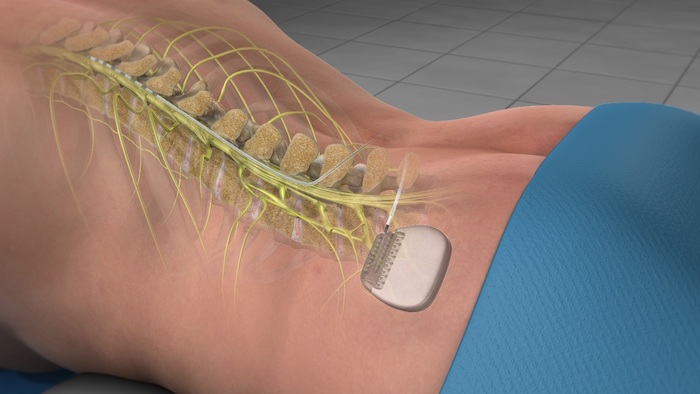
Have you ever wondered why your pain won’t seem to go away? Well, you aren’t alone. Pain is a complex process and long-term, or chronic pain differs greatly from short-term, or acute pain. See Where Does Chronic Pain Come From? to better understand why your pain is persisting.
What Is Spinal Cord Stimulation and How Does a Spinal Cord Stimulator Work?
While there are many options to treat chronic pain, one of the more long-term solutions is the use of a spinal cord stimulator. The name “spinal cord stimulator” may sound intimidating, but it works a lot like a pacemaker except for your nerves instead of your heart. When your heartbeat is overactive, a pacemaker delivers electrical energy to regulate your heartbeat. When your pain is overactive, a spinal cord stimulator delivers electrical energy to the spinal cord to regulate your pain.
Much like a pacemaker, a spinal cord stimulator gets its energy from a very small battery. A spinal cord stimulator uses thin wires called leads that are connected to the battery. The leads have electrodes, again like a pacemaker, and are placed into your epidural space, which is the area between the spinal cord and the bony vertebrae. The electrodes deliver a mild electrical current that helps to disrupt pain signals to your brain, essentially altering, changing, and outsmarting your pain.
Is a Spinal Cord Stimulator Right for Me?
A spinal cord stimulator implant can help treat chronic pain that has not responded to more conservative treatments. If you have tried physical therapy, medications, injections, and even spine surgery and these have all failed to reduce your pain to a manageable level, then spinal cord stimulation may be right for you.
Spinal cord stimulation is used to treat the following conditions but not limited to:
- Post-laminectomy syndrome (Failed back surgery syndrome)
- Chronic low back and/or arm/leg pain
- Intervertebral disc disorder or displacement
- Degenerative disc disease (DDD)
- Complex regional pain syndrome (CRPS)
- Spinal stenosis
- Neuropathy and painful diabetic peripheral neuropathy (pDPN)
- Sciatica or radiculopathy
- Nerve injury
- Spondylosis or spondylolisthesis
- Phantom limb pain or syndrome
- Plexopathy
- End-stage peripheral vascular disease
If you are suffering from any of these conditions and have failed conservative treatments, consider trying spinal cord stimulation to combat your chronic pain.
Can I Trial Spinal Cord Stimulation Before I Decide?
Unlike other implants or surgeries, you trial spinal cord stimulation before you get an implant. How great would it be to try spine surgery before it’s irreversible? Committing to something like this is like buying a car without test-driving it first. The spinal cord stimulator trial allows you to “test drive” spinal cord stimulation before you get an implant. The trial stimulator gives you between 3 and 10 days to decide if spinal cord stimulation will work for you. During this trial, the battery pack remains on the outside of the body, but the leads are placed in the epidural space. The spinal cord stimulator trial is a nonsurgical procedure requiring only two spinal needles to insert the temporary leads into the epidural space. The leads will come out of those two small holes made with the spinal needles and attach to the external battery, but everything will be covered with bandaging during the trial. The spinal cord stimulator trial allows you and your doctor to gauge how you respond to this treatment. Suppose more than 50% of your pain is relieved during the trial or you have significant functional improvement or improvement in your quality of life like you can walk better or garden longer. In that case, you are a good candidate for a permanent spinal cord stimulator implant. The spinal cord stimulator implant is a surgical procedure that requires two small incisions to place the leads and the battery, respectively. For the implant, the leads are tunneled beneath the skin and connected to the battery, so everything is internal.
Precision Pain Care and Rehabilitation has two convenient locations in Richmond Hill – Queens and New Hyde Park – Long Island. Call the Queens office at (718) 215-1888, or (516) 419-4480 for the Long Island office, to arrange an appointment with our Interventional Pain Management Specialist, Dr. Jeffrey Chacko.













